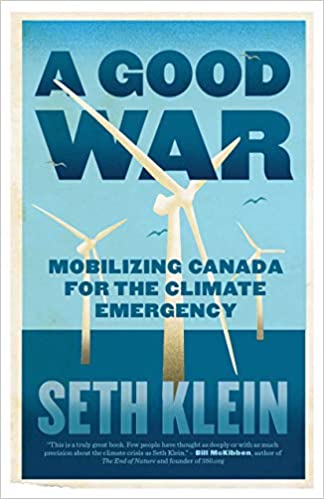A GOOD WAR
by Seth Klein
Book Review.
This book covers the re-building of Canada for WW II, and compares that to the effort needed now to avert a climate catastrophe. The first World War, billed as "the War to End All War," had led rather directly to the second one. It had left us less united with Quebec, and very resentful about the rampant profiteering as well as the senseless slaughter. Accordingly, plans were made right from the beginning on how to get everyone back on board and how to re-convert to a peacetime economy. Fighting the new war meant building whole industries almost from scratch, not just volunteering to take deadly risks. Seeing how much we could do instead of having a depression, we had to be promised that production would continue for things we needed and wanted in peacetime.
The central character in the industrial boom was C.D. Howe, an engineer and entrepreneur, but no idealogue. He did a thorough inventory of our resources and made big plans to convert it into war material. He first asked companies to bid on production. If none were interested, he didn't hesitate to start a crown corporation to do the work. He would also start one just to compete on price if anyone did any serious padding on the cost-plus contracts. The companies became sub-contractors within a totally planned economy, having no say in the priorities, and few chances to cheat. Even the banks lost their monopoly to the Bank of Canada, a very rare event.
Our plutocrats either laid low, afraid to try profiteering, or became fully involved, as if their own lives, or at least their pre-war holdings, were at stake. Indeed, 107 of the very best executives, businessmen, and lawyers became "dollar-a-year" men. For that symbolic salary, and expenses if they wanted to claim them, they worked for Howe, building up new enterprises at a breakneck pace. With everyone cooperating, the transformation was startling, with thousands of state-of-the-art aircraft and sturdy ships being built where there had previously been only small-craft operations in an agricultural and mining country. Flight schools for the whole British Commonwealth seemed to pop up wherever a town could withstand the influx.
When the war was beginning, we had no enthusiasm for it, no strong feeling of duty, and not much idea of what we could do in a modern, mechanized war. Only our leaders saw the danger of the Third Reich to freedom overall. Now, it is the scientists and citizens who see the danger of climate catastrophe, while our major shareholders are dazzled by the profits that can be extracted from disasters, and our political leaders feel beholden to them for campaign financing and other favours.
Compared to what we accomplished in WW II, reversing the carbon buildup in our air seems quite possible, if only we would get started in time. The book is a year old, and we have only nine years of the twelve left to halve our carbon output, according to the IPCC's 2018 report. Basic studies are quoted on all the good effects that conversion would have for jobs and the economy, and at what scale we should work. We are reminded of how rough and ready society has to get to change quickly, and are encouraged to do it again.
Unfortunately, Seth does not notice that the current owners of the Canadian economy don't feel as threatened by the climate crisis as they do by the proposal to leave the tar sands in place, which will crash their paper empires. He does point out that more representative democracies do better at responding to citizen concerns about the climate, and he's rather long on to-do lists, but short on how to get them approved. He writes frequently about the role of unions in the new trades, and not at all about turning to co-op ownership, instead of the capitalism that is at the root of our problems. Turning over the post-war economy to business led to this new war.
For all his admiration for the engineer, C.D. Howe, Seth does not seem to have consulted a similarly original thinker for technical things. There is just one mention of carbon-neutral synthetic fuel, without even noting that it could be a game-changer, and be easily adjusted into a carbon-negative process. Instead, he just wants to electrify everything, without improving on Victorian-style trains and Edwardian busses. Diesel trains have been losing to diesel trucks for decades, and it is not because the locomotives were not electric. There is no mention of the trend to driverless vehicles of any kind, nor of establishing efficient payload standards. We hear of food rationing during the war, but not about the environmental cost of meat for four times as many people now. The rampant extinctions are only mentioned in passing, along with the need to re-invent agriculture, but there are no specifics on its oil dependence now, or the news of alternatives being demonstrated.
However, the book was written to forestall despair, and it does that convincingly by comparing the scale of the hardware challenges. The world as it was is lost, but there is still time to re-build our technology so that it won't ruin all that is left, and start the process of restoration.






